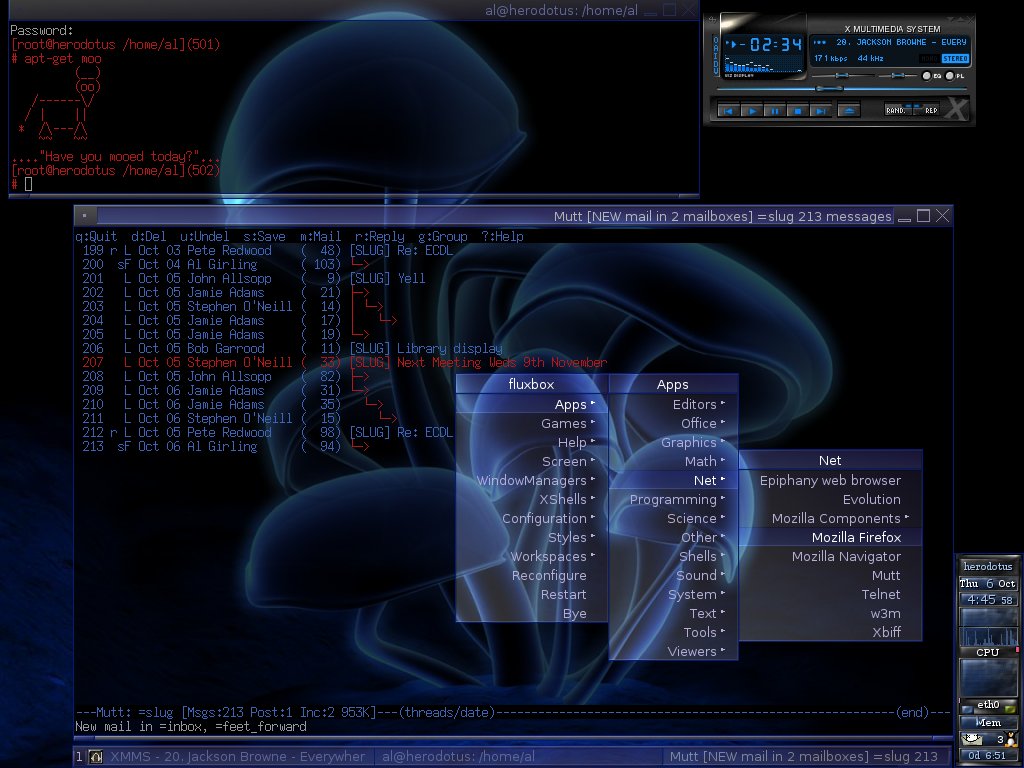Computers
I've been a Linux user since 2002, well, that was when I ditched MS Windows to use nothing but Linux. I certainly don't miss Windows and can't think off hand of anything I can't do that I used to. I can think of plenty that is now available to me that wasn't.
Starting with Mandrake 8.0 I used this for a little over a year before changing to Debian. This is a truly wonderful system and while I've looked at various other distributions I've never been tempted to change.
Here's a screenshot from when I used Fluxbox as my window manager:

In 2005 I felt sufficiently competent to try to set up a user group. Known around the world as a Linux User Group or LUG. A little research and with the help of a couple of others and encouragement of several more the Ryedale Linux User Group held it's first meeting at the Spotted Cow in Malton on the 31st Jan 2006.
It may not be the largest group on the planet, but is still pottering along. For more info please take a look at Ryedale LUG.
You can see some links on the right to the home pages of various bits of software that I use. I'll go through a couple to give an idea of what they do etc.
Vim
VIM is a text editor, based on the classic Unix text editor VI (pronounced vee eye) which in turn has its roots in Ex the old line editor for those who remember the days before screens. The name VIM comes from Vi - IMproved and offers a variety of extra features over the older editor.
One of the curiosities of VIM is that while it is Open Source Software, the author Bram Moolenaar refrains from asking for donations to help with expenses. Instead he simply asks that if you enjoy VIM and find it useful that you donate money to his charity that helps orphaned children in Uganda. What a star eh!
So what does it look like? Here's a screenshot I took showing me using VIM to create this page. While you'll not see any of the funky editing short-cuts I use, it will show the nice syntax highlighting VIM offers with different styles for something like 170 different languages.

I could start listing all the neat ways that VIM speeds up editing text, but I could fill pages like that. What I'll do is create an introduction to VIM and add it to the Ryedale LUG site sometime. What I will say is I use it for most things I do on this computer. If you've ever received an email from me then I can guarantee that it was written with VIM.
GnuPG
GnuPG is an Open Source version of Phil Zimmerman's Pretty Good Privacy. The encryption software that allows you to secure email and all your files with what has been described as 'weapons grade cryptography'. Which should be sufficient to hide your address book etc from prying eyes! Another part of the software is to enable you to digitally sign your files and email. This means that your signature ensures that you can guarantee that if the recipient checks the signature, which proves to be good, the file/email will be from you and that no-one has tampered with it!
GnuPG differs from other encryption software in that instead of relying on the purchase of certificates from authorised companies to guarantee the validity of its digital signatures, it uses what is known as the web of trust. This is simply GnuPG users getting together checking each others identities before exchanging encrypted messages then signing each others keys. The more signatures you have, the more people can trust that you are who you claim to be without ever meeting you.
Here's my public key 0x83A37BA1, although it's available from the public key servers too.
If you have a GnuPG key, you can find out how many people it takes to link to mine through the web of trust using the form below.
Just for curiosities sake, I tried Richard Stallman's key ID 0x135EA668 and found that through the web of trust his key is only three steps away from mine. Surprising huh!
The Web of Trust forms a important part of GnuPG use. Here's a graphical representation of my small WoT.

Here is a 3D 360° view of my WoT. 407kb though, you have been warned. :) I must say, it's losing quality as the WOT gets larger.
More Soon!